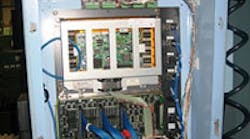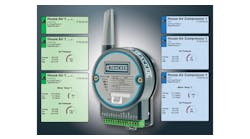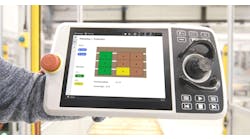The North American manufacturing industry is like a reality TV show, but the obstacles to success are harder to discern, and the competition is more brutal. Tough-minded offshore competitors, currency swings, trade disputes, and customer balance sheet fluctuations created by anything from the financial crisis to Icelandic volcanic activity are just a few of the external factors that determine success or failure.
Inside the factory walls, what counts is productivity, productivity, and productivity. “The cost of raw materials is essentially the same for all machined part manufacturers, and the cost of capital equipment is about the same. Even quality is becoming much the same,” says Sébastien Caron, plant manager for Héroux-Devtek Inc. “So our biggest differentiator is productivity.”
Started in 1942, the publicly traded company with annual sales of $330 million in 2009, Héroux-Devtek manufactures aircraft landing gear, aerostructure, and industrial components at 10 locations across North America. The company’s growth strategy emphasizes acquisitions.
Like most manufacturing headquarters, the Longueuil, Québec head office of Héroux-Devtek Inc. is a paragon of computerized productivity. Centralized, Internet-driven networks control streams of information via enterprise resource planning (ERP) systems, accounting systems, and communications systems that help run the international aerospace and industrial products company.
Until teaming up with Burlington, Ontario-based Memex Automation, it was a different story on the on the factory floors. Individual machine tools were highly automated, but as in many manufacturing operations they remained islands of unconnected information at Héroux-Devtek – like having a group of office PCs, each with a different software application, unconnected by a Local Area Network (LAN) and unable to communicate with each other.
Like most manufacturing companies, Héroux-Devtek wanted a more up-to-date and automated method of measuring machine utilization. In 2007, Héroux-Devtek’s CEO Gilles Labbé set a mandate for standardized devices across the organization to automatically track machine utilization. Even with recently acquired manufacturing operations, he wanted the same kind of unified computerized connectivity on the factory floor that the rest of his company had in the front office.
With a mechanical engineering and project management background, as well as experience working in several of Héroux-Devtek’s manufacturing sites, Caron was charged with eliminating low machine productivity in a company-wide OEE (overall equipment effectiveness) initiative.
“I knew that there were other Héroux-Devtek sites looking at OEE devices to track machine utilization,” says Caron. “Many of our plants were working towards individual implementations. Some sites were ahead of the rest, and some sites had not started at all. We realized that it would be beneficial to have a common OEE platform for all sites. After talking to all our plant managers, we decided on a common approach. Dedicated individuals from each site worked in collaboration to successfully implement the Memex product, taking into account their specific operational environments.”
“We had a meeting at our Kitchener, Ont., landing gear plant to make a requirements list and decided to get presentations from seven suppliers. We then ‘down selected’ the suppliers for pilot OEE implementations,” continues Caron. “Memex had a relationship with the Kitchener plant for many years as a Direct Numerical Control (DNC) supplier to feed CNC part programs to our machines. As we came to understand their strengths in OEE, it also made sense to have compatible technology monitoring feedback from our machines.”
“After fully evaluating the pilot programs, we decided to go with Memex over a three-year roll-out. We now have Memex OEE + DNC systems installed on 74 machines in six manufacturing plants, and another 59 machines will be connected over the next couple of months.”
Memex OEE + DNC product is attached directly to each machine and provides local memory, embedded software, high-speed network connectivity, real-time automatic machine state and utilization data collection, and adaptive, Web-based control that will enhance and improve machine tools. Every machine tool in each plant, or in every plant, can be monitored from any Web-based computer located anywhere, from the plant manager’s office to the CEO suite.
On the plant floor, operators supplement the Memex machine automation with a hand-held unit that tracks up to 13 different user-defined time loss categories, such as unscheduled maintenance or setup. If one machine presents unique downtime issues the inputs can be adjusted to pinpoint the problem. And, new functionality introduced this year sends automated e-mail or SMS text alerts to the PCs, smart phones, or cell phones of supervisors if a machine has breached a pre-set operating parameter, such as elapsed time in a particular mode greater than a preset threshold, or other customized settings particular to a given plant process or individual machine.
“We had passive OEE and now we have active OEE,” says Caron. “We can react immediately. The key to better productivity is not just to track performance, but to act on problems in real-time.”
The Memex hardware and software toolset can connect to any machine in a plant including CNC machine tools, conventional or hydraulic punch presses, injection-molding machines, and manual processes or machines.
Memex unites the islands of machine automation, establishing a fully connected, enterprise-wide manufacturing nervous system that gives real-time visibility of production and the ability to adapt and control each machine. The benefits of internetworked machine monitoring lead to increased productivity that typically leads to an increase in shop floor efficiency.
Caron speaks directly to the productivity potential from Héroux-Devtek’s investment in Memex systems. “Based on the information we were getting from the factory floor, we believed we were operating at a much higher machine utilization than Memex output indicated. This actually shocked us. When you have Memex OEE results, you can question assumptions and realize you can improve processes and downtime, and really focus on that. This is far, far cheaper than buying new machines.”
“We now have a tool to communicate to the people on the shop floor that our performance can improve. Customers can see and believe in what we’re doing to improve on-time delivery when we show them our data in quarterly reviews,” says Caron. “Because you can only act on what you can measure, Memex helps people share a vision of an overall productivity goal – and that helps us be more competitive.”
Caron is satisfied with the working relationship between Héroux-Devtek and Memex. “We had to get IT involved to link Memex OEE data with our ERP system. We wanted to get the two systems to talk to each other, so our IT group had to give Memex clear direction. On their part, the Memex team has responded well and been open to support the unique challenges of each plant’s operations, so that we now have a truly internetworked plant floor system.”
“We are also glad we standardized on one OEE solution. If we allowed each plant to implement a unique solution, our IT group would have been immersed in integration work for years.”
Even though Memex systems automate machine automation, Caron claims the OEE data it provides improves human as well as machine-to-machine communications. “At our Dorval plant for example, we are implementing work-cell teams. One of the metrics we will use is OEE data to show operators how they are doing. We will see an overall daily productivity number to demonstrate there is room for improvement, and then we will meet with teams to discuss how to reduce downtime. We believe we can use Memex data to motivate employees with a shared understanding of how we can be more productive, and that’s what it’s all about.”






